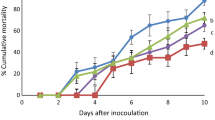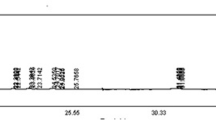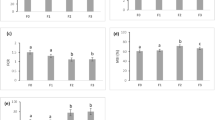Abstract
The in vitro digestibility of lipids from Chaetoceros muelleri that were cultured in Guillard medium (F/2) and agricultural fertilizer medium (AF/2) and performance index was examined in enzymatic extracts of Litopenaeus vannamei larvae. The highest enzymatic activity (EA) of lipases was observed in Zoea I (1.53 ± 0.14 EA/10 EU) and Mysis I (1.26 ± 0.01 EA/10 EU (EU are units of enzymatic activity)) when C. muelleri was grown in the F/2 medium. The highest concentration of the unsaturated fatty acids (UFAs) in C. muelleri was observed with F/2 medium (9.96 μg FA/106 cells), and the lowest was obtained with (AF/2) medium (6.68 μg FA/106 cells). The percentage of the total highly unsaturated fatty acids (HUFAs) in Zoea (18.23 %) and Mysis I (F/2 = 19.32 %, AF/2 = 20.25 %) larvae was similar between culture media. The performance indices (PI) of shrimp larvae (Zoea I to Mysis I) differed between culture media, with higher values of PI recorded with the F/2 medium-cultured algae (14.3 ± 1.1) with respect to the values with the AF/2 medium-cultured algae (8.0 ± 1.8). We concluded that due to the effect of the nitrogen source in AF/2 medium, C. muelleri cells have a lower HUFA content and L. vannamei larvae experience decreased lipid digestibility and performance index.

Similar content being viewed by others
References
Abuin E, Lissi E, Solar C (2005) Effect of urea on the enzymatic activity of a lipase entrapped in AOT-heptane-water reverse micellar solutions. J Colloid Interface Sci 283:87–93
Bligh EG, Dyer WJ (1959) A rapid method of total lipid extraction and purification. Can J Biochem Physiol 37:911–917
Bradford MM (1976) A rapid and sensitive method for the quantization of microgram quantities of protein utilizing the principle of protein-dye binding. Anal Biochem 72:248–254
Brown MR, Jeffrey SW, Garland CD (1989) Nutritional aspects of microalgae used in mariculture, a literature review. In: Marine laboratories report 205. Commonwealth Scientific and Industrial Research Organisation (CSIRO), Australia, p 44
Carrapiso A, García C (2000) Development in lipid analysis: some new extraction techniques and in situ transesterification. Lipids 35:1167–1177
Díaz-Iglesias E, Brito-Pérez R, Báez-Hidalgo M (1991) Cría de postlarvas de langosta Panulirus argus en condiciones de laboratorio. Memorias del Taller Internacional sobre Ecología y Pesquerías de Langosta. Rev Invest Mar Cuba 12:323–331
D’Souza FM, Loneragan NR (1999) Effects of monospecific and mixed-algae diets on survival, development and fatty acid composition of penaeid prawn (Penaeus spp.) larvae. Mar Biol 133:621–633
Fidalgo JP, Gid A, Abalde J, Herrero C (1995) Culture of the marine diatom Phaeodactylum tricornutum with different nitrogen sources: growth, nutrient conversion and biochemical composition. Cah Biol Mar 36:165–173
Fraser AJ (1989) Triacylglycerol content as a condition index for fish, bivalve, and crustacean larvae. Can J Fish Aquat Sci 46:1868–1873
Geurden I, Coutteau P, Sorgeloos P (1997) Effect of a dietary phospholipid supplementation on growth and fatty acid composition of European sea bass (Dicentrarchus labrax L.) and turbot (Scophthalmus maximus L.) juveniles from weaning onwards. Fish Physiol Biochem 16:259–272
Glencross BD, Smith DM, Thomas MR, Williams KC (2002) The effect of dietary n-3 and n-6 fatty acid balance on the growth of the prawn Penaeus monodon. Aquaculture 205:157–169
González R, Fraga V, Carrillo O (1994) Cambios ontogénicos en la actividad de las principales enzimas digestivas de Penaeus schmitti. Rev Invest Mar Cuba 15:262–268
González-Félix ML, Gatlin DM, Lawrence A, Pérez-Velázquez M (2002) Effect of various dietary lipids on quantitative essential fatty acid requirements of juvenile Pacific white shrimp Litopenaeus vannamei. J World Aquacult Soc 33:330–340
Guillard RRL (1975) Culture of phytoplankton for feeding marine invertebrates. In: Smith WL, Chantey MH (eds) Culture of marine invertebrate animals. Plenum, New York, pp 29–60
Hach (1997) Water analysis handbook. Hach Company, Loveland, p 1309
Liang Y, Beardall J, Heraud P (2006) Effects of nitrogen source and UV radiation on the growth, chlorophyll fluorescence and fatty acid composition of Phaeodactylum tricornutum and Chaetoceros muelleri (Bacillariophyceae). J Photochem Photobiol 82(B):161–172
Liao IC, Chien Y-H (2011) The Pacific white shrimp, Litopenaeus vannamei, in Asia: the world’s most widely cultured alien crustacean. In: Galin BS, Clark PF, Carlton JT (eds) In the wrong place-alien marine crustaceans: distribution, biology and impacts. Springer, Netherlands, pp 489–519
Lourenço SO, Barbarino E, Mancini-Filho J, Schinke KP, Aidar E (2002) Effects of different nitrogen sources on the growth and biochemical profile of 10 marine microalgae in batch culture: an evaluation for aquaculture. Phycologia 41:158–168
Lovett D, Fólder DL (1990) Ontogenic change in digestive enzyme activity of larval and postlarval white shrimp Penaeus setiferus (Crustacea, Decapoda, Penaeidae). Biol Bull 178:144–159
Madigan M, Martinko J, Parker J (2003) Biología de los microorganismos. In: Macromolecules, Capítulo 3, 10th edn. Editorial Person, Madrid, p 1011
Merican ZO, Shim KF (1995) Apparent digestibility of lipid and fatty acid in residual lipids of meal by adult Penaeus vannamei. Aquaculture 133:275–286
Nolasco H, Del Monte-Martínez A, Hinojosa P, Civera-Cerecedo R, Vega-Villasante F (2006) Digestibilidad in vitro de lípidos alimentarios para el camarón. In: Cruz-Suárez E, Ricque DM, Tapia-Salazar M, Nieto-López M, Villareal-Cavazos DA, Puello Cruz A, García-Ortega A (eds) Avances en nutrición Acuícola, VIII Simposium Internacional de Nutrición Acuícola. Monterrey, Universidad Autónoma de Nuevo León, pp 15–17
Pacheco-Vega JM, Sánchez-Saavedra MP (2009) The biochemical composition of Chaetoceros muelleri Lemmermann grown with an agricultural fertlizer. J World Aquac Soc 40(4):556–560
Palacios E, Racotta LS, Heras H, Marty Y, Moal J, Jean-Francois S (2002) Relation between lipid and fatty acid composition of eggs and larval survival in white pacific shrimp (Penaeus vannamei, Boone, 1931). Aquac Int 9:531–543
Rivera-Pérez C, Navarrete Del Toro MA, García-Carreño FL (2010) Digestive lipase activity through development and after fasting and re-feeding in the white leg shrimp Penaeus vannamei. Aquaculture 300:163–168
Sánchez-Saavedra MP, Voltolina D (2006) The growth rate, biomass production and composition of Chaetoceros sp. grown with different light sources. Aquac Eng 35:161–165
Versaw KW, Cuppet LS, Winters DD, Williams EL (1989) An improved colorimetric assay for bacterial lipase in nonfat dry milk. J Food Sci 54:1557–1568
Ziaei-Nejad S, Habibi Rezaei M, Azari Takami G, Lovett DL, Ali-Reza M, Shakouri M (2006) The effect of Bacillus spp. bacteria used as probiotics on digestive enzyme activity, survival and growth in the Indian white shrimp Fenneropenaeus indicus. Aquaculture 252:516–524
Acknowledgments
This study was founded by the CICESE (623108) and SEP-CONACyT (130074) and to UABCS (AICM-CTM-04-11-25-11-05-24) projects. Thanks to Patricia Hinojosa for her technical support at the Comparative Physiology Laboratory of the Centro de Investigaciones Biológicas del Noroeste (CIBNOR). We would like to thank “AQUALAB” for supplying the shrimp larvae.
Author information
Authors and Affiliations
Corresponding author
Rights and permissions
About this article
Cite this article
Pacheco-Vega, J.M., Sánchez-Saavedra, M.d.P., Cadena-Roa, M.A. et al. Lipid digestibility and performance index of Litopenaeus vannamei fed with Chaetoceros muelleri cultured in two different enriched media. J Appl Phycol 28, 2379–2385 (2016). https://doi.org/10.1007/s10811-015-0750-y
Received:
Revised:
Accepted:
Published:
Issue Date:
DOI: https://doi.org/10.1007/s10811-015-0750-y




